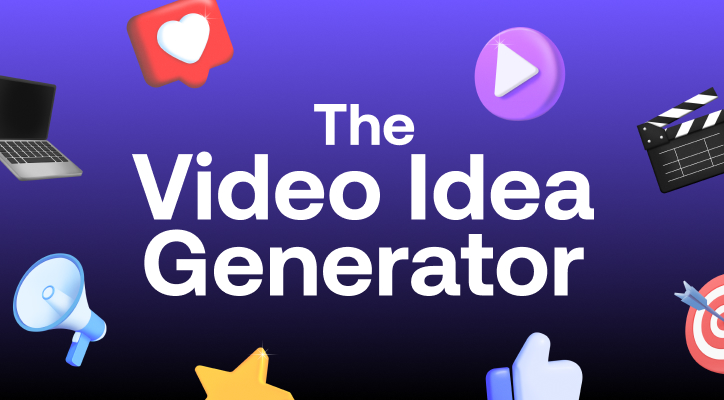Create a narrative and a script
Next, decide on the type of narrative you'd like to create in your video. Some popular storytelling narratives include…
- Linear Narrative - this is where you tell the entire story linearly, in the order it happened.
- Non-linear narrative - Have you ever watched videos that started with flashbacks and went to and fro between different timelines? That's non-linear narrative storytelling. It's a great way to add interest to your videos.
- Quest narrative - In this type of narrative, your story's hero works tirelessly towards a goal.
- Viewpoint narrative - This is where a brand shares viewpoints of different customers or employees to create an engaging, relatable story.
Once you've decided on the type of storytelling video you want to create, begin writing a script. Even a rough draft will do at this point. So you can start gathering resources, figuring out sets, and shortlisting people who'd make an appearance in your video.
Decide on the video mediums you will publish to
Instagram, Facebook, TikTok? Or perhaps YouTube? Where are you planning to post the video? Which social media audience are you targeting?
A video for TikTok will likely look quite different from a video for LinkedIn.
Therefore, understanding where you want to publish the video and why will help you decide on your video format.
Use the right equipment (camera, microphone, lighting)
Start gathering the essential equipment to shoot your video. If you're outsourcing your video, then your work's done here. But if you're planning to shoot it yourself (and save some dollars), the first thing you need to do at this point is to invest in the right equipment.
There's no need to go all out and splurge on the top-of-the-line equipment - you can shoot a pretty good video with your iPhone or Samsung camera and some natural light.
Look around you and see if there are any free sets you can work with (especially if you can use outdoor spaces or your office space). Find budget-friendly but excellent quality microphones, cameras, and lighting setups you can use.
When shopping for the right equipment, keep your budget in mind and invest in a few solid pieces that will last you a long time.
Film your video
Before you press 'record,' here are a few tips to keep in mind when you start filming your video to ensure you get the best live footage:
- Make sure you keep the camera rolling at all times - the extra footage is going to come in handy in post-production
- Shoot multiple times the same scene if needed - don't just shoot a scene once and get done with it. If you think it doesn't look right, reshoot it.
- If you're using stock images or videos, or even content created independently by your customers, make sure they're high-quality and go seamlessly with the rest of your video.
Edit the video
The post-production of your video can take just as long as the filming part. This is because it's essential to put all the right 'finishing touches' to make your video even better.
A few tips to keep in mind when editing the video:
- Keep in mind that 1 screen should be equal to 1 idea.
- Add transitions and motion designs to add oomph to your video.
- Add subtitles - Don't forget, 'when subtitles are included, 80% more people watch videos to completion!
- Add a final CTA. This is where you remind your audience of your key goal for your video. Display your call-to-action clearly at the end of the video to encourage viewers to take action!
Distribute the video on all your relevant marketing channels
You've done all the hard work. The video looks excellent, and it's time to start promoting it on all your marketing channels.
Even if you've made the video primarily for YouTube, you can always repurpose its content and upload snippets of it on all your social media channels. You can still drive more and more viewers to your YouTube channel.
When posting the video on social media, choose an optimal time, add a great caption, pay attention to its thumbnail, and engage with all the comments you get on the video.
6 best practices to make your video storytelling effective
When creating a powerful, high-converting storytelling video, keep the following tips in mind, so you don't get too preoccupied with the filming, editing, or how it looks aesthetically.
Focus on the key message
Don't let other video elements such as music or visual effects overtake your key message. What is the one thing you want your viewers to take away? Are you trying to introduce your new product, convince your audience to invest in your course, or simply introduce your brand to a new audience?
Whatever your goal is, be sure to center the story around it.
Use emotional triggers
Understand what emotional triggers your audience responds well to - is it happiness, fear, sadness, or surprise? Identify this and think of elements in your video that can help you evoke them, such as music or imagery.
Other emotional triggers can include:
- Color psychology
- The power of the right sound effect
- Social proof
- Experiences
Be relatable
Remember: you're creating a product to engage a specific audience. So you need to know it better than you know your best friend. Understand their likes, wants challenges, and needs. Instead of discussing your product features and benefits, make it all about them.
Keep it short
When creating videos, make sure to keep your videos under 2 minutes. But this really depends on the goal of your video and where you plan on featuring it.
And if you don't want to show your face, you can use our AI avatar feature.
3 great brand video storytelling examples
Now that you know how to create videos for brand storytelling, here are some excellent examples to inspire you:
Ben & Jerry’s: Company social mission video


